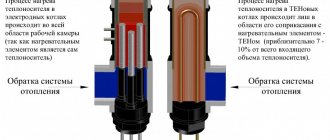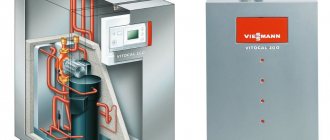The most common way to heat a country house is to connect a gas boiler. Gas is the most readily available and cheapest fuel. But there are areas where it is impossible to connect to the gas pipeline, and then you have to look for other options. Heating a country house with a gas boiler without connecting to the mains is theoretically possible if you install a gas tank or use LPG cylinders. This method is expensive and inconvenient. There is an alternative. To decide which heating of a country house without gas is worth choosing, you need to figure out the availability and cost of other types of fuel.

Our ancestors have long used wood stoves to heat their homes. Traditions are still alive today
Options for heating a country house without gas
A private house can be heated with solid fuels - wood, coal, pellets. Stoves, fireplaces, solid fuel boilers are used as heating devices. This is the oldest method of heating a home, and for some regions it is still the cheapest and most affordable.
Liquid fuel boilers are installed to heat the house. This heating option is suitable for people who, for objective reasons, cannot equip gas heating of a country house, but have access to liquid fuel and are ready to equip storage tanks for it.
Electricity is a very expensive source of heat. It makes sense to install electric heating if the area of the room is relatively small and other heating options are unacceptable.
Technologies do not stand still, and more and more often you can find installations for generating electricity from alternative sources - sun and wind. Heat pumps are used to heat houses. This is a relatively new and not yet the most popular way of heating, but gradually it is gaining the trust of residents of some European countries. Our compatriots are already adopting their experience.
Further in the article we will consider the advantages and disadvantages of the listed heating options.


To install a floor-standing liquid fuel boiler, it is advisable to allocate a separate room. The photo shows a variant of the boiler room equipment in the basement
What energy sources are there to choose from?
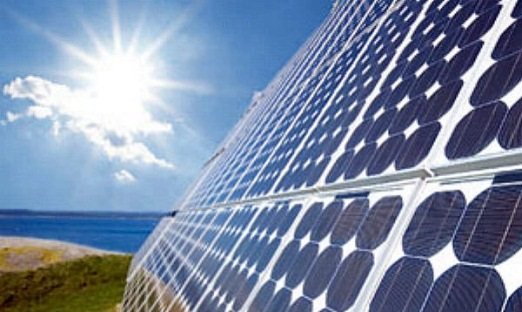

By default, we immediately exclude the two main energy sources from the list: electricity and natural gas. Then we have at our disposal:
- various biomass: wood, coal, straw, sawdust and so on;
- imported hydrocarbon fuel: liquefied gas in cylinders or diesel fuel;
- alternative energy sources.
The latter include installations capable of extracting heat contained in air, land or water. But the most affordable ways to heat a house without traditional energy resources is the combustion of biomass in order to heat water or air. The situation is more complicated with liquefied gas or diesel fuel, their initial cost is quite high, and together with delivery it will be completely transcendental. Again, electricity is needed for high-quality burning of diesel fuel.
Alternative heating for a private house, which has just begun to develop, is still considered very expensive and not available to everyone. But behind him is the future, because in terms of efficiency, such heating is unmatched. If you do not take into account the various exotic sources of energy, then the choice will have to be made from two options:
- inexpensive and affordable, but troublesome combustion of biomass;
- expensive, but economical and comfortable sources of alternative energy.
Diesel fuel and propane should be excluded from the list; these sources are not suitable for anyone.To effectively burn diesel fuel, you need electricity, which means a solar battery. Propane consumption even for a small house will be so great that you will quickly get tired of changing and bringing new cylinders. As a result, heating costs will still be unacceptable.
https://youtu.be/unqT3p88EFQ
Heating a country house with solid fuel
Solid fuel heating has been and remains popular in non-gasified areas. Russian stoves are still being built in private houses. Many people install industrial heating stoves. Manufacturers offer multifunctional models that allow you to heat your home with high quality, cook food, and heat water. Particularly popular are boilers and long-burning stoves that use fuel as efficiently as possible. Economical and convenient, these models can be a worthy alternative to gas boilers.
The wood-burning fireplaces should be mentioned separately. They perform a heating function and serve as an interior decoration. There are designs with hobs, ovens, while the firebox door is transparent, through it you can watch the play of the flame. Fireplaces equipped with vertical opening doors make it possible to instantly transform efficient closed-hearth stoves into fireplaces with cozy crackling woods.
Solid fuel boilers and stoves also have disadvantages. They need to be cleaned regularly, put firewood on, and take care of replenishing fuel supplies on their own. Bulky Russian stoves have many advantages, but they take up a lot of space and are difficult to build. Industrial models are compact, safe to operate, have high efficiency, but many of them are demanding on fuel quality. When choosing a design, the decision should be carefully weighed.
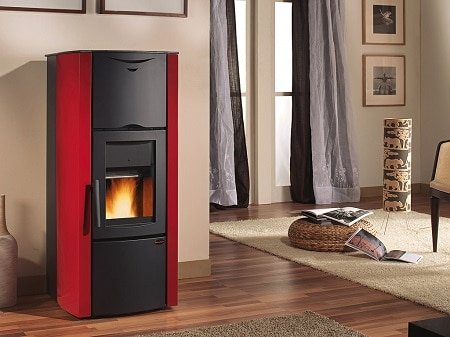

Modern solid fuel boilers are efficient, compact and look good in the interior
Oil fired boilers: advantages and disadvantages
Liquid fuel boilers are almost as good as gas boilers in terms of performance. A 10 kW model can heat a room up to 100 sq. M. Diesel fuel, kerosene, fuel oil, rapeseed oil, etc. are used as fuel. This heating equipment is easy to install and does not take up much space. However, there are numerous disadvantages as well.
A separate room is required to install the boiler. Equipment of this type can hardly be called environmentally friendly: the combustion of diesel fuel generates a large amount of harmful emissions. There is also a safety issue: storage and use of diesel fuel requires strict adherence to safety regulations and manufacturer's recommendations. Another unpleasant nuance is the high cost of diesel fuel.
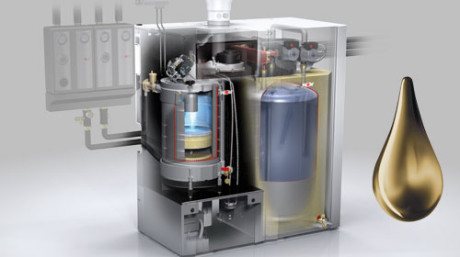

Liquid fuel boiler device
Heating with LPG
Another option for heating a house without main gas and electricity can be the use of liquefied gas for this purpose. Especially if there is no desire to heat with solid fuel. There are two options: you can use several cylinders with liquefied gas, connected to each other, or a special container - a gas holder, which is refueled with special equipment. The use of liquefied gas as a source of thermal energy will cost more than heating with gas from the mains or solid fuel, but somewhat cheaper than with liquid fuel.
The advantage of heating a house with liquefied gas:
- convenience of heating, which practically does not differ from heating with main gas;
- when using a gas convector, you can heat the house in which you live periodically.
Disadvantages:
- Quite high cost of this type of heating;
- With constant heating of the house, it is necessary to often deliver and change cylinders or mount a gas tank and be able to refuel it.
- Read more about heating with liquefied gas.
Electricity is expensive, but convenient and efficient
Of all types of heating boilers, electric ones are the most convenient to use and easy to install. For their operation, no smoke exhaust systems are needed, there is no burning and soot, no need to clean the firebox and monitor the equipment. Reliable automation regulates the temperature, in modern models, overheating protection systems are installed. The level of security is high. Of the minuses - the high cost of electricity, the need for special control over the condition of the electrical wiring. For the installation of powerful models, coordination with the competent authorities is required.
Underfloor heating systems and ceilings
Underfloor heating works well as primary heating in mild climates and can be a good additional heat source in harsh climates. The advantage of underfloor heating is that the room warms up well at the level of human height. This creates a comfortable indoor climate. The novelty of the heating equipment market is infrared warm floors. They are economical, do not overheat, and are easy to install.
Infrared heaters or special films on the ceiling also help create a cozy atmosphere in the home. The peculiarity of infrared heating devices is the ability to warm objects and people. The air is heated indirectly - from objects. Radiation from the ceiling heats furniture, floors, and interior items. A person feels a soft warmth, reminiscent of the sun. Infrared heating not only creates comfort in the home, but also has a therapeutic function.
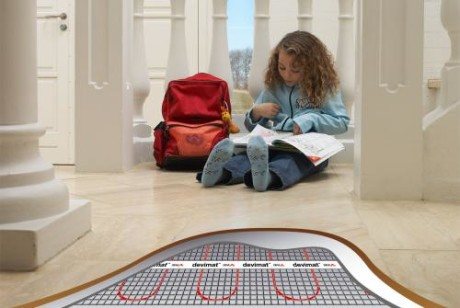

Underfloor heating is ideal for heating children's rooms, living rooms, bedrooms
Electric heating
Electric heating involves converting electrical energy into thermal energy. For this purpose, various boilers are used that run on electricity. The following are the most common methods of electric heating:
- Electric boilers. Heating elements are built in such units. There can be one or several of them. If there are several of them, then the user himself can activate only one of them or all of them at once. It is a system of pipes through which the coolant moves and is heated by the flowing electric current. Powerful units are connected to a three-phase network. In some electric boilers, there is no heating element. Instead, electrodes are provided. Electric current is transferred from one electrode to another through the water. So he heats her up. Usually, in such systems, not water, but antifreeze is used as a coolant.
- Heating electric convectors. In appearance, they resemble ordinary radiators, only now they are connected to the electrical network. They also do not use a coolant. The heating element is enclosed in a special insulator. A current passes through it, it heats up, as a result of which the surrounding air heats up, which immediately rises up.
- Infrared heaters. They have a special device that converts electrical energy into infrared rays. These infrared rays travel in a straight line and only heat objects that are in their path. For full heating, you will have to install several such units. Thanks to this device, you can create zones with high and low temperatures in the room.
- Electric floor. It is a system of high resistance current conductors. They are installed in the floor and heat up as a result of the passage of current through them. This heat then heats up the surface of the floor, the heat from which is transferred to the air in the room.
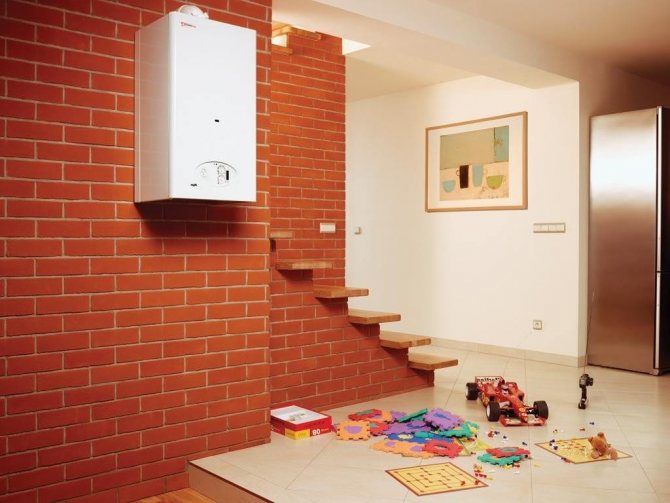

These are the types of electric heating that exist at the moment.Now you should consider all the pros and cons of this heating method.
So, the advantages of electric heating are as follows:
- The efficiency of electric boilers is high. According to various sources, approximately 99% of electricity is converted into thermal energy.
- Environmental friendliness. When using electricity, no emissions of harmful substances into the atmosphere occur.
- Automaticity. Most electric boilers operate in automatic mode, that is, a person only needs to adjust accordingly.
- Security. Unlike gas, where there is a risk of leakage, electricity is less dangerous.
And now about the cons:
- The first and most important disadvantage is electricity tariffs. Most boilers that are connected to a three-phase network operate at high power, therefore energy consumption is high.
- Dependence on an uninterrupted supply of electricity. If suddenly, for some reason, there is a power outage, the devices stop their work. But this problem can be solved by installing additional automation.
Alternative energy - sustainable heat
Hydrocarbon reserves are not endless, and their combustion causes significant damage to the environment. "Green" energy is developing, and it is already possible to install installations that allow you to abandon the services of gas and electricity suppliers. The most widespread are solar collectors and batteries.
The principle of operation of solar systems is to convert the energy of the sun into heat. Wind generators are successfully used for the same purpose. The main disadvantage of environmentally friendly energy sources is complete dependence on external factors. They are not applicable in many localities. The installations themselves are still too expensive for the average citizen.
Heat pumps - a promising novelty
More and more attention is paid to heat pumps. These are more reliable devices than solar panels. The principle of their operation is based on the transfer of heat from low-potential sources to high-potential ones. There are these types of pumps:
- soil-water;
- water-water;
- air-water;
- air to air.
Ground-water systems can be used in almost any climatic conditions, so they are no longer considered something exotic, and they can be seen in the private households of our compatriots. The cost of installing a heat pump is decreasing every year, so it is likely that soon environmentally friendly heating systems will be available to everyone.


Heat pump operation diagram
If there is no connection to the gas pipeline, the problem of heating the house can be solved. The main thing is to determine the needs and decide how much you are willing to spend on the purchase and installation of equipment, how much you are willing to pay when operating the system. If the “money issue” is fundamentally important, it is worth taking a closer look at solid and liquid fuel boilers, and if you are ready to overpay for convenience, safety and environmental preservation, then choose electricity or eco-installations.








